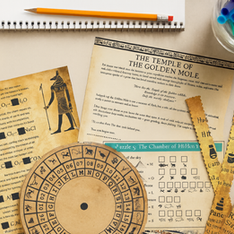The Best Hands-On Activity to Teach the Periodic Table (Students Love It!)
- Androy Bruney
- Mar 13
- 4 min read
My High School Chemistry Nightmare
Let me take you back to my high school chemistry class—learning the periodic table was, quite frankly, a nightmare. My chemistry teacher handed us a dense chapter to read and a dry summary sheet of periodic trends. That was it.
No explanations. No discussions. No connections to the bigger picture. Just a list of things to memorize.
Spoiler alert: I struggled... Badly...
Chemistry felt like a random collection of numbers and symbols, totally detached from reality. It wasn’t until college, during my undergraduate studies, that the periodic table finally clicked.
Why the Periodic Table Deserves a Better Introduction
The periodic table isn’t just a chart of elements—it’s the Rosetta Stone of chemistry. It reveals relationships, predicts properties, and explains why elements behave as they do. Without understanding its structure and logic, students are left floundering, trying to piece things together with no real foundation.
But when we introduce the periodic table in a way that’s engaging, hands-on, and interactive, it transforms from a memorization task into a fascinating exploration of patterns and properties. Students start asking questions. They see the connections. They stop memorizing trends and start understanding why those trends exist.
Why Inquiry-Based Learning is the Best Way to Teach the Periodic Table
Instead of telling students how the periodic table works, what if we let them discover it for themselves? Inquiry-based learning makes this possible.
Benefits of Inquiry-Based Learning
Engaging: Students drive the process by exploring questions and solving problems, tapping into their natural curiosity.
Builds Critical Thinking: Instead of passively absorbing information, students analyze patterns, evaluate evidence, and draw their own conclusions.
Boosts Retention: When students actively construct knowledge, they retain it longer. Discovering concepts on their own makes connections stronger than any lecture could.
By using inquiry-based learning, we’re equipping students with tools they’ll use throughout chemistry and beyond. This method encourages deep thinking and meaningful connections, setting the stage for real understanding—not just rote memorization.
So next time you introduce the periodic table, leave the summary sheet in your desk drawer. Instead, try this hands-on, student-centered activity that will make chemistry click.
Engaging Periodic Table Activity: Robot Sorting
This activity is hands-down one of my favorite ways to introduce the periodic table. Inspired by Sunrise Science, it flips the script on the usual “here’s the table, memorize it” approach.
Instead of passively receiving information, students engage in hands-on discovery, mirroring the process that scientists used to create the periodic table.
How It Works
Distribute Robot Cards: Each student (or group) gets a set of quirky, colorful robot cards featuring different features like antennas, multiple arms, and bold colors.
Sorting Task: Their only instruction? Sort them. Some students will group by the number of arms, others by color patterns or specific features. The beauty of this step is that there’s no wrong way to start.
Pause & Reflect: Ask questions like:
Why did you group the robots this way?
What patterns did you notice?
How would you describe the ‘rules’ you followed?
Connect to the Periodic Table: This is where the magic happens! Students realize their sorting method mirrors how scientists organized elements based on shared properties and atomic numbers.
Suddenly, the periodic table doesn’t feel so abstract—it’s a giant puzzle, just like their robot activity!
Why This Activity Works
✔ Flexible: You can add more structure (e.g., a worksheet with a table-like layout) or let students struggle a little to figure it out on their own.
✔ Encourages Discovery: Like early scientists, students experiment with classification before being handed a complete system.
✔ Scaffolds Learning: For advanced learners, use robot cards with complex serial numbers to challenge their pattern-recognition skills.
Reflection & Extension
After the activity, students complete a reflection sheet comparing their robot groupings to the actual periodic table. You can also introduce a challenge where they design a missing robot card, mimicking how scientists predicted missing elements before they were discovered.
This isn’t just a lesson about the periodic table—it’s an opportunity for students to:
✔ Develop critical thinking skills
✔ Practice pattern recognition
✔ Understand the “why” behind the table’s organization
And the best part? They love it.
Taking It Further: The Jigsaw Method for Periodic Trends
Once students grasp the structure of the periodic table, I love using a Jigsaw activity to dive deeper into periodic trends.
How to Run a Jigsaw Activity on Periodic Trends
Divide the class into small groups, assigning each group a periodic trend, such as atomic radius, ionization energy, or electronegativity.
Each group becomes an “expert” on their trend, researching and identifying patterns.
Groups present their findings to the rest of the class, completing a larger picture of how the periodic table organizes and predicts element behavior.
Why It Works:
Collaborative – Every student participates.
Builds on Prior Learning – Reinforces key ideas without overwhelming students.
Encourages Deep Understanding – Students analyze trends, rather than just memorizing them.
👉 Learn more about how I use the Jigsaw method to teach periodic trends here.
Why This Approach Matters
Teaching the periodic table isn’t just about memorizing symbols and numbers—it’s about helping students see its elegance and logic. The periodic table is a testament to human ingenuity, and when students engage with it as a puzzle to be solved, they develop genuine appreciation for its structure.
So, the next time you’re introducing the periodic table, skip the lecture. Instead, grab some robot cards, encourage curiosity, and watch as students truly understand chemistry for the first time.
Try It Out!
💡 Have you tried a hands-on approach to teaching the periodic table? Share your experience in the comments below!
🎯 Looking for ready-to-use hands-on chemistry activities? Check out my Teachers Pay Teachers (TPT) store!












